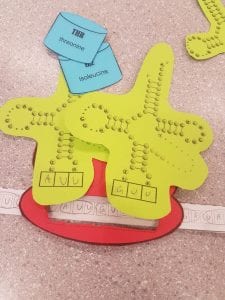1. Initiation: mRNA binds to the small ribosome subunut, then the 2 ribosome subunits bind together. Elongation: Ribosome holds mRNA and allows complimentary tRNA to attach to binding sites. Then tRNA binds to the “P site”, another tRNA binds to the “A site”. Binding cayses changes, the amino acid lets go of tRNA and binds to neighbouring amino acid. Finally, “empty” tRNA leaves the ribosome, the ribosome moves along mRNA, now the second tRNA is at the “P site” and new tRNA binds to the mRNA codon at the “A site”. Termination: the elongation cycle continues until mRNA reads a stop codon. No new amino acid is added to the chain, so the ribosome dissociates into its 2 subunits and the polypeptide is released. Stop codon: a 3 letter code which doesn’t have a matching tRNA/amino acid. ( UAG, UGA, UAA)
2.We were able to learn about each process of protein synthesis by recreating it. Each process we had to go through was an easy-to-understand way of learning what was going on in our bodies. Although there were some difficulties and it was not the exact way it happens in our bodies, it was a good representation of protein synthesis and learning activity. In our body the processes are much quicker and may have more mistakes.







Leave a Reply